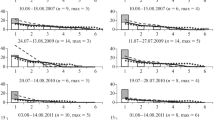Summary
The immigration of carabids into the Lauwerszeepolder (constructed in 1969) was studied in 4 areas. These areas have different types of soil and consequently different vegetations. The carabid fauna was sampled by means of striptraps and window traps. In this way a total number of 116000 specimens was caught.
A comparison of the catches shows great differences between the fauna in different study areas in successive years. The data are compared with those of another Dutch polder (IJsselmeer polder). It is shown that about 50% of all species caught are able to fly. Moreover it is demonstrated that relatively more specimens of sparse populations than of dense populations fly.
The data, especially those on ovarian development, show that flight occurs mostly in early adult life. Moreover, flight muscle autolysis at the onset of ovarian development is a common feature among carabids. Females fly more readily than males. Whereas the flight of most species covers only short distances, some species fly across the borders of their habitats. The data suggest five categories in carabids with respect to flight.
Brachypterous carabids were very rarely found in the polder. It is suggested that changes in the numbers of macropterous specimens in carabid populations outside the polder proper are not due to dispersal.
The role of migration in the stabilization of carabid populations is estimated to be very small.
Similar content being viewed by others
References
Den Boer, P.J.: On the significance of dispersal power for populations of carabid beetles (Coleoptera, Carabidae). Oecologia (Berl.) 4, 1–28 (1970)
Den Boer, P.J.: Stabilization of animal numbers and the heterogeneity of the environment: The problem of the persistance of sparse populations. Proc. Adv. Study Inst. Dynamics Numbers Popul. (Oosterbeek, 1970), P.J. den Boer, G.R. Gradwell, Eds., pp. 77–97. Wageningen: Pudoc 1971
Van Dijk, Th.S.: The age-composition of populations of Calathus melanocephalus L. analysed by studying marked individuals kept within fenced sites. Oecologia (Berl.) 12, 213–240 (1973)
Haeck, J.: The immigration and settlement of carabids in the new IJsselmeerpolders. In: Dispersal and dispersal power of carabid beetles, P.J. den Boer, Ed., pp. 33–52. Wageningen: Veenman & Zonen N.V. 1971
Heydemann, B.: Die Biotopstruktur als Raumwiderstand und Raumfülle für die Tierwelt. Verh. dtsch. zool. Ges. 50, 332–347 (1957)
Heydemann, B.: Die biozönotische Entwicklung vom Vorland zum Koog. II. Teil: Käfer (Coleoptera). Abh. Akad. Wiss. Lit. Mainz. Math.-naturwiss. Kl. 11, 170–370 (1962)
Jeannel, R.: Coléoptères Crabiques. Faune de France, T 39 et 40. Paris: Librairie de la Faculté des Sciences 1941/1942
Joenje, W.: Production and structure in the early stages of vegetation development in the Lauwerszeepolder. Vegetatio (to be published in 1974)
Johnson, C.G.: Migration and dispersal of insects by flight. London: Methuen 1969
Lindroth, C.H.: Die Fennoskandischen Carabidae I. Göteborg Vetensk. Samh. Handl. B4, no. 1 (1945)
Lindroth, C.H.: Biological investigations on the new volcanic Island Surtsey, Iceland. In: Dispersal and dispersal power of carabid beetles, P.J. den Boer, Ed., pp. 65–69. Wageningen: Veenman & Zonen N.V. 1971
Meijer, J.: Immigration of arthropods into the new Lauwerszeepolder. In: Dispersal and dispersal power of carabid beetles, P.J. den Boer, Ed., pp. 53–64. Wageningen: Veenman & Zonen N.V. 1971
Meijer, J.: Die Besiedlung des neuen Lauwerszeepolders durch Lauflkäfer und Spinnen. Faun.-Ökol, Mitt. 4, 169–184 (1973)
Neumann, U.: Die Sukzession der Bodenfauna (Carabidae (Coleoptera), Diplopoda und Isopoda) in den forstlich rekultivierten Gebieten des Rheinischen Braunkohlenreviers. Pedobiologia 11, 193–226 (1971)
Reddingius, J., Den Boer, P.J.: Simulation experiments illustrating stabilization of animal numbers by spreading of risk. Oecologia (Berl.) 5, 240–284 (1970)
Southwood, T.R.E.: Migration of terrestrial arthropods in relation to habitat. Biol. Rev. 37, 171–214 (1962)
Thiele H.-U.: Wie isoliert sind Populationen von Waldcarabiden in Feldhecken? In: Dispersal and dispersal power of carabid beetles, P.J. den Boer, Ed., pp. 139–151. Wageningen: Veenman & Zonen N.V. 1971
Vlijm, L.: Some reflections on dispersal. In: Dispersal and dispersal power of carabid beetles, P.J. den Boer, Ed., pp. 139–151. Wageningen: Veenman & Zonen N.V. 1971
Vlijm, L., Van Dijk, Th. S.: Ecological studies on carabid beetles. II. General pattern of population structure in Calathus melanocephalus L. at Schiermonnikoog. Z. Morph. Ökol. Tiere 58, 396–404 (1967)
Weidemann, G.: Die Stellung epigäischer Raubarthropoden im Ökosystem Buchenwald. Verh. dtsch. zool. Ges. 65, 106–116 (1972)
Author information
Authors and Affiliations
Rights and permissions
About this article
Cite this article
Meijer, J. A comparative study of the immigration of carabids (Coleoptera, Carabidae) into a new polder. Oecologia 16, 185–208 (1974). https://doi.org/10.1007/BF00345882
Received:
Issue Date:
DOI: https://doi.org/10.1007/BF00345882



